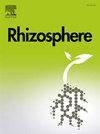利用响应面方法优化 Niallia circulans YRNF1 的抗真菌和固氮活性,以控制辣椒镰刀菌根腐病并促进植物生长
IF 3.4
3区 生物学
Q1 PLANT SCIENCES
引用次数: 0
摘要
本文章由计算机程序翻译,如有差异,请以英文原文为准。
Optimization of antifungal and nitrogen-fixing activities of Niallia circulans YRNF1 using response surface methodology to control Fusarium root rot of pepper and promote the plant growth
Sweet pepper crop is exposed to Fusarium root rot, caused by Fusarium solani (Mart.) Sacc., resulting in great economic losses. In this study, culturing conditions for nitrogen-fixing and biocontrol activities of Niallia circulans YRNF1 were optimized in vitro using the response surface methodology. Results indicated that the optimum culturing conditions for both activities were initial pH = 6, glucose concentration of 27.5 mgL−1, temperature of 13.5 °C, and incubation time of 12.3 days. In the greenhouse, inoculating the infected pepper plants with N. circulans YRNF1, grown under optimized conditions, reduced the disease severity to 24.8%, compared to 37.3% in case of the un-optimized N. circulans YRNF1. In addition, three defense-related genes (CHI II, C4H, and H3F) were highly overexpressed more than in case of the un-optimized bioagent. Treating the infected plants with N. circulans YRNF1, grown under the optimized conditions, triggered the plant defense responses through inducing the phenolic compounds accumulation and activities of two antioxidant enzymes; POD and PPO. Inoculating the infected plants with the optimized N. circulans YRNF1 promoted their shoot height and root length (22.00 and 9.00 cm, respectively) and the flowers number, compared to the untreated infected plants (17.33 and 4.00 cm, respectively). Moreover, application of the optimized N. circulans YRNF1 on the pepper plants led to a significant increment in the total nitrogen content in pepper roots (206.97%), compared to those inoculated with the un-optimized bioagent (181.39%). Optimization of the culturing conditions of N. circulans YRNF1 represents a promising and eco-friendly approach for supporting the organic and sustainable agriculture.
求助全文
通过发布文献求助,成功后即可免费获取论文全文。
去求助
来源期刊

Rhizosphere
Agricultural and Biological Sciences-Agronomy and Crop Science
CiteScore
5.70
自引率
8.10%
发文量
155
审稿时长
29 days
期刊介绍:
Rhizosphere aims to advance the frontier of our understanding of plant-soil interactions. Rhizosphere is a multidisciplinary journal that publishes research on the interactions between plant roots, soil organisms, nutrients, and water. Except carbon fixation by photosynthesis, plants obtain all other elements primarily from soil through roots.
We are beginning to understand how communications at the rhizosphere, with soil organisms and other plant species, affect root exudates and nutrient uptake. This rapidly evolving subject utilizes molecular biology and genomic tools, food web or community structure manipulations, high performance liquid chromatography, isotopic analysis, diverse spectroscopic analytics, tomography and other microscopy, complex statistical and modeling tools.
 求助内容:
求助内容: 应助结果提醒方式:
应助结果提醒方式:


